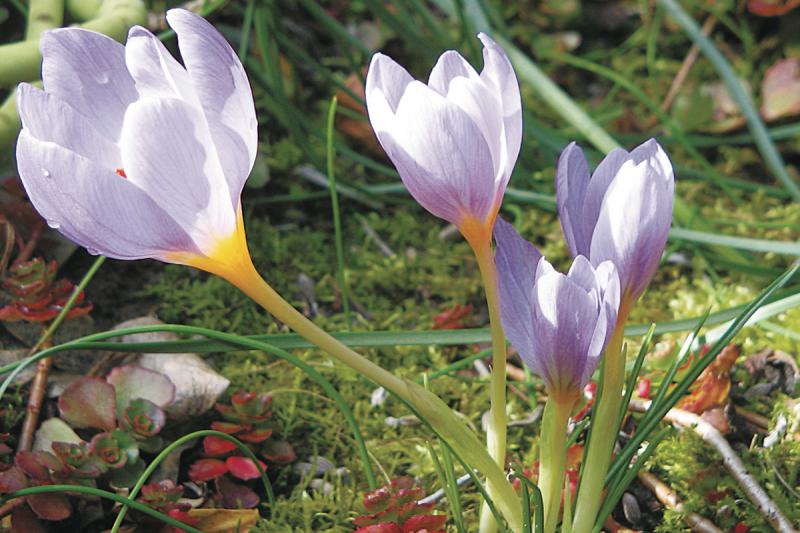Enjoy fall-blooming crocus before next spring
The lightbulb so profoundly changed the world that even today we use the image of a lightbulb to show an idea in a cartoon.
Why a light “bulb” not a light tuber or a light root? Because they resemble what ancient Greeks called bolbos, “plant with round swelling on underground stem.” By 1800 a bulb was also an enlarged glass tube such as a thermometer bulb.
With the thermometer bulb about to get chillier, this is the time to plan and plant bulbs. Many specialty bulbs need to be ordered in late summer. The earlier you can plant bulbs the better. All flower bulbs need to settle in and grow strong roots before winter. Be sure you plant flower bulbs where the soil drains well. Water newly planted flower bulbs immediately, and once a week if there is no rain.
But you don’t have to wait for next spring to enjoy fall-blooming crocus that you can plant right now.
These small flowers will create a splash of color late in the garden year when it is needed most. Best of all, they will naturalize and come back for years with almost no care.
The best known fall-blooming bulbs are probably the autumn crocus or Colchicum. It is not even a true crocus but is more closely related to lilies. Colchicums bloom with large, goblet-shaped flowers in shades of light pink, deep violet and pure white. The Water Lily variety will produce five to 10 double pink fall flowers.
Another favorite fall-blooming crocus is the saffron crocus, grown from a corm rather than a true bulb. Each lilac-purple flower contains just three red stigmas, and it is these stigmas that are used for flavoring. Saffron imparts a deep yellow color to whatever dish it seasons from paella to breads. You will want to plant at least 25 saffron crocus to get any sort of a meaningful crop, although even a few in a pot can give you the ultimate homegrown gourmet touch.
The saffron crocus should multiply over the years until after four to six years, you may have to dig up, divide and replant the saffron crocus corms to give them more room. Divide them immediately after the leaves fade.
Saffron crocus grows best in full sun with moderately rich soil. Ideally, the ground should stay dry in summer, while the corms are dormant.
With their bright colors that contrast with the more muted colors of early autumn, fall crocus, saffron crocus and colchicums make a good choice for small yards, pots and in a rock garden.
Plant any of the autumn crocus or saffron crocus about four inches deep and four inches apart. To keep gophers, mice, or other pests at bay, plant them in pots or use hardware cloth or a wire mesh around the planting holes. In just six to eight weeks after planting your fall crocus will be in full bloom.
Sometimes it will take two seasons before they bloom. The flowers last a good three weeks, with the leaves appearing right when the flowers emerge, or fairly soon after. These leaves will last for three months or so before they die. Because you won’t see any sign of life for months on end, you may want to mark the area where they’re planted. That way when you are working in the yard next year you will remember where you planted them, and a lightbulb will go off just like the cartoons.
























































